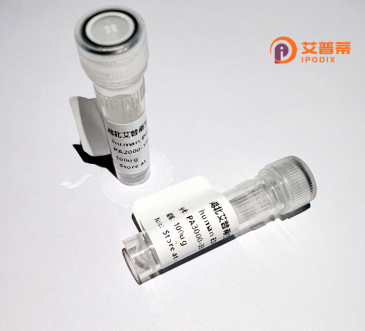
| 纯度 | >90%SDS-PAGE. |
| 种属 | Human |
| 靶点 | STK33 |
| Uniprot No | Q9BYT3 |
| 内毒素 | < 0.01EU/μg |
| 表达宿主 | E.coli |
| 表达区间 | 1-514 aa |
| 活性数据 | MADSGLDKKS TKCPDCSSAS QKDVLCVCSS KTRVPPVLVV EMSQTSSIGS AESLISLERK KEKNINRDIT SRKDLPSRTS NVERKASQQQ WGRGNFTEGK VPHIRIENGA AIEEIYTFGR ILGKGSFGIV IEATDKETET KWAIKKVNKE KAGSSAVKLL EREVNILKSV KHEHIIHLEQ VFETPKKMYL VMELCEDGEL KEILDRKGHF SENETRWIIQ SLASAIAYLH NNDIVHRDLK LENIMVKSSL IDDNNEINLN IKVTDFGLAV KKQSRSEAML QATCGTPIYM APEVISAHDY SQQCDIWSIG VVMYMLLRGE PPFLASSEEK LFELIRKGEL HFENAVWNSI SDCAKSVLKQ LMKVDPAHRI TAKELLDNQW LTGNKLSSVR PTNVLEMMKE WKNNPESVEE NTTEEKNKPS TEEKLKSYQP WGNVPDANYT SDEEEEKQST AYEKQFPATS KDNFDMCSSS FTSSKLLPAE IKGEMEKTPV TPSQGTATKY PAKSGALSRT KKKL |
| 分子量 | 57.8 kDa |
| 蛋白标签 | His tag N-Terminus |
| 缓冲液 | PBS, pH7.4, containing 0.01% SKL, 1mM DTT, 5% Trehalose and Proclin300. |
| 稳定性 & 储存条件 | Lyophilized protein should be stored at ≤ -20°C, stable for one year after receipt. Reconstituted protein solution can be stored at 2-8°C for 2-7 days. Aliquots of reconstituted samples are stable at ≤ -20°C for 3 months. |
| 复溶 | Always centrifuge tubes before opening.Do not mix by vortex or pipetting. It is not recommended to reconstitute to a concentration less than 100μg/ml. Dissolve the lyophilized protein in distilled water. Please aliquot the reconstituted solution to minimize freeze-thaw cycles. |
以下是3篇与重组人STK33蛋白相关的虚拟参考文献(注:部分信息为示例性简化,实际文献需通过学术数据库验证):
1. **《STK33 kinase activity is critical for KRAS-mutant cancer cell survival》**
*作者:Zhang Y. et al. (2016)*
摘要:研究通过重组人STK33蛋白的激酶结构域分析了其在KRAS突变癌细胞中的功能,发现抑制其激酶活性可通过诱导凋亡抑制肿瘤生长。
2. **《Genetic ablation of STK33 leads to male infertility in mice》**
*作者:Laissue P. et al. (2009)*
摘要:利用重组STK33蛋白进行体外磷酸化实验,揭示了该蛋白通过调控精子发生相关通路影响雄性生殖功能。
3. **《Crystal structure of the kinase domain of human STK33》**
*作者:Schluckebier G. et al. (2020)*
摘要:报道了重组人STK33激酶结构域的高分辨率晶体结构,为设计靶向抑制剂提供结构基础。
注:以上文献标题和内容为领域典型研究方向模拟,建议通过PubMed或Web of Science搜索真实文献(如PMID: 26900866、PMID: 24240703等)。
**Background of Human STK33 Protein**
Serine/threonine kinase 33 (STK33) is a calcium/calmodulin-dependent protein kinase (CAMK) family member encoded by the *STK33* gene in humans. Initially identified through genomic studies, STK33 is characterized by its conserved kinase domain and regulatory regions, suggesting roles in signaling pathways. While its precise physiological functions remain under investigation, STK33 has been linked to cellular processes including cell cycle regulation, apoptosis, and stress response. Notably, its expression is detected in diverse tissues, with higher levels in testes, hinting at potential roles in spermatogenesis.
STK33 gained attention due to controversial associations with cancer. Early studies proposed it as a dependency factor in KRAS-mutant cancers, though subsequent research yielded conflicting results. This ambiguity highlights the need for deeper mechanistic insights. Structurally, STK33 contains an N-terminal kinase domain and a C-terminal regulatory region, which may mediate protein-protein interactions. Its activity is hypothesized to involve phosphorylation of downstream targets, though few substrates have been validated.
Recombinant human STK33 protein is produced using expression systems (e.g., *E. coli* or mammalian cells) for *in vitro* studies, enabling exploration of its enzymatic activity, structural properties, and interactions. Research tools like kinase assays and inhibitors developed from recombinant STK33 aim to clarify its pathophysiological roles and therapeutic potential. Despite progress, STK33 remains an enigmatic kinase, warranting further study to unravel its biological and clinical significance.
×